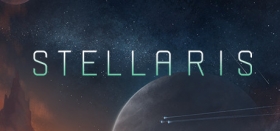
EGX 2017: Stellaris Utopia Preview
Last week at the Electronic Gaming Expo in London, I had the opportunity to test Stellaris first major gameplay expansion, Utopia. Accompanied by game designer Daniel Moregård, I spent nearly an hour within the interstellar empire-building game and it’s amazing depth of features.
“This is our first real, big gameplay expansion”, Daniel tells me, “and we really tried to give people a lot of options and things to do.” The previous “expansion”, Leviathans, was more of a story pack that added a couple of new features -- none of it shook up the way the game played, and it didn’t revamp or add new mechanics like Utopia does. The latest expansion changes the flow of the entire game, from the moment you create a race to the endgame direction your species will take.
Stellaris: Utopia adds a number of new features to the game, all of them aiming to give players more control and options when it comes to shaping their empire’s path through the galaxy. The biggest addition is undoubtedly the Megastructures -- gigantic space constructs that take massive amounts of resources and alienpower to produce. Ranging from enormous space stations that function as orbital “habitats” to gargantuan ringworlds not unlike Halo’s namesake structures, each of those projects give you massive benefits not attainable in any other way and often take an inordinate time to be completed.

Another megastructure is an old staple of science fiction: the infamous Dyson sphere. A truly monumental construct, Dyson spheres are massive round structures built around a sun in order to completely envelop it, harvesting every single joule produced by the entrapped star but rendering its planetary system cold and lifeless. During the presentation, Daniel showed me the construction phases of a Dyson sphere, which had an estimated build time of five in-game years. Using multiple saves to take me to it’s completion, I was able to see the finished megastructures before our appointment (or the day) were over.
“It is a bit more endgame focused, which is something we felt was a bit lacking”, he told me. Due to the massive logistical effort involved in those megastructures, I asked if the expansion’s main goal was endgame content. “No, we definitely want to give players a more meaningful experience through the game”, said Daniel, “and Utopia and the Banks update also adds new race features and social options for your races”.
The 1.5 Update, aka “Banks” (after famed Scottish sci-fi author Iain Banks), is a free update to Stellaris that brings with it a host of new features, in typical awesome Paradox fashion. Adding things like governmental Ethics skill trees, a reworked faction system, an unrest mechanic that affects planets and can spark rebellions, the ability to set Species Rights for individual species, terraforming barren planets, and more, the actual patch notes as of the time of publishing is ridiculously long. The Banks update adds the foundation for things found on Utopia, such as slavery and purge options, and helps flesh out the gameplay even for vanilla players.

The paid DLC options are a bit more extensive, with players able to create “hive-mind” races where every single individual is part of a single organism, giving it a whole mind-control vibe. Non hive-mind species can even be converted and assimilated into your civilisation, creating a galaxy-wide group of mindless drones. After your empire finds its footing in the galaxy, you will slowly gain access to Ascension Perks, the pinnacle of societal evolution: choosing from one of three different paths, you can choose if your civilisation shall be biological, psionic, or synthetic. Each path offers a myriad of options and drastically alters the way the game progresses after it’s effects start to take place -- synthetic races can become cyborgs and live virtually forever, while psionic races can access a higher dimension called “The Shroud” and find it’s way to enlightenment -- or bring destruction upon themselves.
“The Shroud is a separate dimension where beings of immense power live, but they’re not all bad”, Daniel tells me. “It’s a bit like The Warp from 40K, but without all the Chaos and demons -- the Shroud has some areas full of good things, other areas with more neutral things, and some areas where some evil things are”. Using developer commands, he speeds up the gameplay and shows me some things that might happen to species that try to access the Shroud and draw power from it, and an event pop-up shows a huge swirling cloudy void, abound with lightning and darkness. “That’s how I see the Shroud; like in that movie ‘Arrival’, where the aliens are behind a glass and you can see something moving, but you don’t know what it is”, Daniel says.

Paradox has a good track record of sincerely supporting their products post-launch and turning them into much more than they originally were, and if Utopia is the first step in that path, Stellaris is headed in a fantastic direction. The addition of major gameplay changes on the free patch, like Traditions and Ethics, alongside meaningful paid features on the DLC expansion demonstrate a desire to keep improving across the board. and that comes as a welcome relief in a world of day one patches and rushed sequels.
Stellaris: Utopia is out on the 6th of April, alongside the free 1.5 Banks update.









COMMENTS